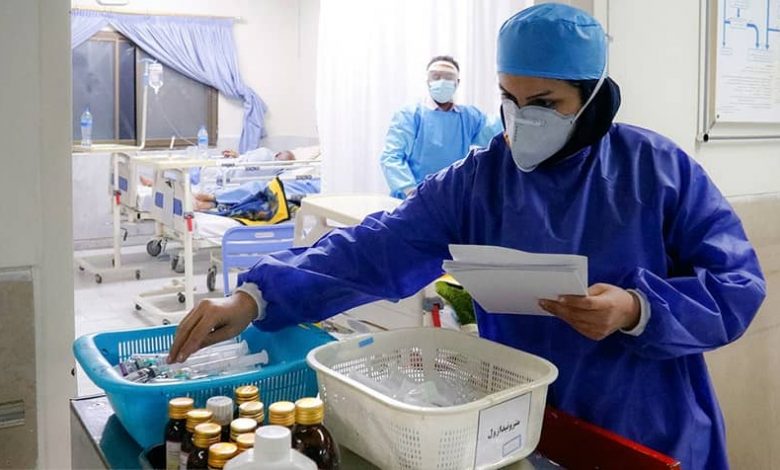ran’s Coronavirus Disinformation Strategy Falls Apart in the Presence of a Vaccine

Written by
Mansoureh Galestan
Though global fatalities from Covid-19 are approaching 1.7 million, there is finally light at the end of the tunnel. Governments throughout the world have begun purchasing and distributing vaccines which proved to be effective in clinical trials, and may gradually reduce the general impact of the coronavirus before ultimately ending the pandemic altogether. That end will not come at the same time for everyone, but developed nations are almost invariably starting down a road to recovery.
There appears to be one notable exception, however, and that is Iran. There, state media is still telling citizens that they will most likely have to wait until summertime for a vaccine to even be available. This is because Iran’s theocratic dictatorship has apparently resolved to eschew the vaccines that are now available on the open market, in favor of developing another one domestically.
This while Iran’s coronavirus outbreak has been the worst in the Middle East, and among the worst in the world, since very soon after it was first publicly acknowledged in February. There is evidence to suggest that that acknowledgement was late in coming, with regime authorities holding back information from the public in order to encourage participation in national elections and celebrations of the Islamic Republic’s anniversary. These apparently became state-promoted super-spreader events, and set the country on the path toward its current situation, with more than 50,000 officially recorded deaths.
Nevertheless, information has leaked via non-official sources and it has yielded an exceptionally grim picture of Iran’s coronavirus infection rate and death toll. According to the National Council of Resistance of Iran (NCRI), there have been over 186,900 Iranian deaths attributable to Covid-19, while the total number of infections now numbers in the millions.
The NCRI’s reporting is based on records from hospitals and morgues throughout the country, as well as eyewitness testimony from various sources that have communicated with the intelligence network maintained by the People’s Mojahedin Organization of Iran (PMOI-MEK). Its assessments emphasize that many recent fatalities have been hospital employees, and that this has naturally exacerbated the situation by leaving medical facilities understaffed at the same time they are over-capacity with Covid patients.
Such reports evoke a clear picture of a situation that is still snowballing. This stands in direct opposition to the regime’s public statements. State media tends to insist that the situation is well in hand, but those efforts to downplay the crisis only serve to make it worse by convincing the regime’s supporters and uninformed citizens that it is safe for them to go about their business. Then again, many Iranians do not have a choice in the matter, as their poverty long pre-dates the pandemic and has left them in the situation of having to choose between the certainty of starvation if they stay home and the strong possibility of coronavirus infection if they return to work.
Unsurprisingly, millions have continued working throughout the nearly year-long crisis. Their ability to do so has hardly been diminished by government lockdowns, as these were late in coming, brief in duration, and weakly enforced. Meanwhile, the regime provided no incentive for people to avoid going about life as usual, while the regime’s Supreme Leader Ali Khamenei and the Islamic Revolutionary Guard Corps (IRGC) each control literally hundreds of billions of dollars in assets which they could easily use to keep the people alive.
Their fundamental disinterest in doing so was underscored by ongoing expenditures on foreign paramilitary interventions and the support of regional terrorists and dictators like Hezbollah and Syrian President Bashar al-Assad. These warped priorities help to explain why the regime has so few qualms about deliberately putting its people in positions where they might catch the disease. Yet it may still be shocking to some readers that the same regime would turn a blind eye to an available solution and callously instruct its people to wait six to nine more months while the rest of the world starts on the path to recovery.
On the other hand, this extraordinary neglect of the public welfare may also be explained by the regime’s commitment to spending money on its malign activities, over and above any measures that might help the Iranian people. It may be that Tehran has simply decided it would be too expensive to buy adequate supplies of the vaccine from foreign suppliers while still keeping up the flow of cash to its foreign militant proxies. In that case, the regime will have decided that it would rather sacrifice tens of thousands of its own citizens than any of its leverage in foreign affairs.
Virtually all of the Iranian regime’s decision-making over the past three years has been focused on forestalling further unrest. Its efforts to downplay the coronavirus pandemic while denying its own mismanagement are no exception. The strategy may have shown some effectiveness in holding back the tide when there was no real solution for the crisis, only a series of best practices for slowing the spread and limiting its mortality. But with a vaccine now on the market, this is no longer the case. And the Iranian people are overwhelmingly aware of that fact.
Even Mohammad Reza Mahboubfar, a member of Iran’s own coronavirus response taskforce, has expressed the new stakes in stark terms: “If the other countries start the vaccination while we are still waiting, society’s tolerance will end.”

